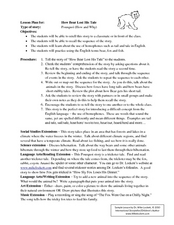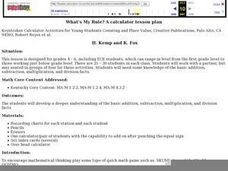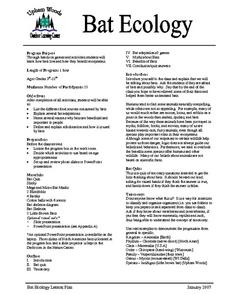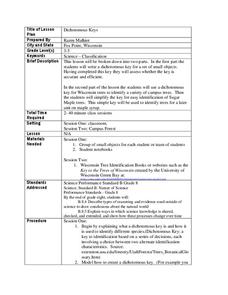Curated OER
Do It Write
Students investigate types of communities. For this communities lesson, students read the book The Country Mouse and City Mouse and identify the characteristics of the city and country. Students participate in a pen-pal program with a...
Channel Islands Film
Santa Cruz Island - Visible Thinking Routines
Visible Thinking Routines are designed to help learners deepen their understanding of what they are learning and enable them to communicate their understanding of concepts to others. Individuals adopt one of these routines to use to...
Curated OER
Animal Signs
Students discuss the many different types of animal signs that can be used to identify and track animals. They participate in an hands-on activity in which they examine tracks, trails, homes, territory markings, and even "scat" left by...
Curated OER
Animal Signs
Students discuss the many different types of animal signs that can be used to identify and track all types of animals. They examine tracks, trails, homes, territory markings, and even "scat" left by animals and attempt to identify the...
Curated OER
Natural Communication
Students investigate communication as an adaptation by examining visual, tactile, chemical and auditory communication. They study the characteristics of the red fox an songbirds.
Curated OER
Cool Flip Books
Students assemble a flip book to visualize cause and effect, problem solving and sequencing. They use the books to show movement, color and different types of elements of art.
Curated OER
Skulls Tell It All
Skulls tell it all, and with this lesson plan, you will tell it all to your class! Youngsters view animal skulls, analyzing the shape of teeth and the placement of the eye sockets. They associate these adaptations with the types of food...
Science Matters
Energy Transfer and Transformation
When you take a simple task and create an exceptionally difficult way to complete it, it is known as a Rube Goldberg machine. These machines are filled with many types of energy transfers and energy transformations. Here, pupils watch...
Curated OER
Introduction to Myths, Fables, and Legends
Middle schoolers identify elements of myths, fables, and legends as they read an example of each. After reading an example of each type of story, they list elements from each. They compare and contrast these features by completing a...
Curated OER
Flower Dissection
Students dissect three different flowers and compare and contrast them. In this flowers lesson plan, students learn about the flower anatomy and then dissect their own flowers.
Curated OER
How Can We Write A Story Using Dr. Seuss' Writing and Illustration Style?
Students write a story. In this writing style and illustration instructional activity, students review elements of Dr. Seuss' writing and illustration style and read a few more books written by him, examining the writing style. ...
Curated OER
Understanding and Writing Fables
Third graders review with the teacher the characteristics for a fable and what it is. They read one paragraph each from the story, "The Fox and the Stork" aloud. They then answer comprehension questions aloud. Next, they listen to four...
Curated OER
Animals in the Media
Sure to activate young minds, this resource asks learners to consider how media influences their personal points of view. Pupils examine how animals are portrayed in the media to understand why they feel the way they do about those...
Curated OER
"Julie of the Wolves"
Fifth graders research life in Alaska and compare life there to their lives in this instructional activity. They read "Julie of the Wolves." They research through the novel and other reference books facts about the Alaskan climate and...
Curated OER
Hollow Hilton
Students identify animals that depend on their environment for survival. They describe the relationship between living things. They draw or write an explanation of their findings.
Curated OER
How Bear Lost His Tale: Storytelling
In this storytelling lesson plan, children practice re-telling the story of "How Bear Lost His Tale", review and write out the story sequence, and learn about homophones like tail/tale, sail/sale, etc. Extension activities for various...
Curated OER
Calculators
Students investigate the four basic operations of mathematics that are addition, subtraction, multiplication, and division. The use of a technology game is part of the lesson. They demonstrate the proper use of a calculator as part of...
Curated OER
Bats
Students investigate bats. In this animal science lesson, students use several websites and suggested bat books to write an informative paragraph. Students should be able to write with 90% accuracy.
Curated OER
Bat Ecology
Students, through hands on games and activities, discover how bats live and how bats benefit ecosystems. They play a game designed to show them how echolocation works and another to show how mother bats locate their young through their...
Curated OER
Dichotomous Keys
Students utilize dichotomous keys to identify trees in their schools. In this ecological identification lesson, students practice creating dichotomous keys based on simple subjects such as hair color or sex of a person. Students use...
Curated OER
Night Hike
Young scholars explore Upham Woods at night and investigate about the special adaptations of nocturnal animals. They identify three nocturnal animals and how they are adapted to the night. Students explain what night vision is and how it...






















